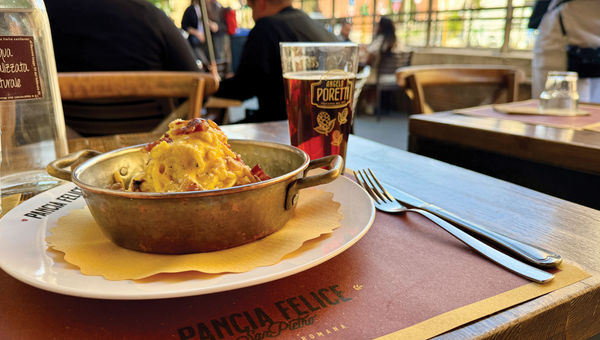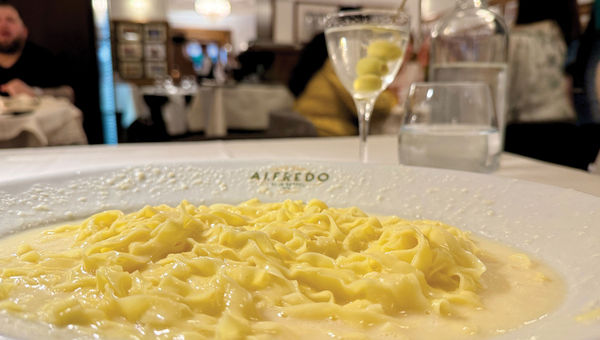ROME — While on a Perillo group tour of the Vatican Museum, I asked our local guide, Mario, what food or dish Rome is known for. He gave me several recommendations and I tried three of them. All were pasta dishes.
Cacio e pepe
For several years now, I’ve wondered why I have heard compliment after compliment, rave review after rave review, about how good cacio e pepe is.
“What’s so great about pasta with cheese and black pepper,” I would say in a huff at the mere mention of this dish.
While I love cheese, I’m very particular about black pepper and I only like a sprinkle on some dishes, and certainly not all.
But when a Roman tells you to have cacio e pepe in Rome, you have cacio e pepe in Rome.
And within seconds of taking my first bite I could instantly taste the years I had wasted in protest, in ignorance of this cheesy pile of perfection.
It struck me as criminal that the ingredients of a dish this good could be so simple, but it is. Cacio e pepe has just four ingredients: pecorino romano cheese, black pepper, tonnarelli pasta and the starchy pasta water emulsified with the cheese.
I had cacio e pepe at a restaurant in Rome called Il Segreto, which was a short Uber ride away from the Starhotel Michelangelo where I was staying. It was delicious.
Carbonara
Carbonara, allow me to introduce myself, as I do believe I have never had the pleasure.
This was another lovely pasta dish I tried for the first time at Pancia Felice, a restaurant around the corner from my hotel.
I sat down for lunch after a long and busy day touring the Vatican Museum and St. Peter’s Square, all of which worked up my appetite for something hearty.

Carbonara at Pancia Felice. Photo Credit: Nicole Edenedo
So I walked over to Pancia Felice and had my carbonara dish al fresco, dining outside in the sidewalk seating area.
The carbonara was also very good. It was slightly drier than the cacio e pepe. Carbonara is made with egg yolks; pecorino romano; fried, diced pork such as guanciale (cured pig cheek), pancetta or bacon; black pepper; and pasta water.
The carbonara at Pancia Felice came with bacon, which meant this pasta dish and I were already off to a good start. What I liked about the carbonara was the varied textures, from the creaminess of the sauce to the crispiness of the bacon.
Fettucine Alfredo
“Who is Alfredo?!”
That is the question some old Italian friends of mine from Los Angeles would exclaim in jest every time an American would bring up fettucine Alfredo, with that particular American most often being me.
I was led to believe that the popular dish was an American invention inspired by a pasta dish that originally had its roots in Italy.
And to my surprise on this trip with Perillo Tours, I found out that not only is fettucine Alfredo a pasta dish that did indeed originate in Italy, the restaurant that created the dish is right here in Rome!
And while Americans co-opted the dish and made their own version over the years, fettucine Alfredo is, indeed, very much Italian.

Fettucine Alfredo at Alfredo alla Scrofa, where the dish originated. Photo Credit: Nicole Edenedo
My tour director, Irene Capano, a native Roman, made a reservation for me at the restaurant where the staple originated, Alfredo alla Scrofa.
Once inside, I immediately recognized that this was a famous place. There are tons of photographs on the wall of Old Hollywood celebrities like Joan Crawford, Gregory Peck and Gary Cooper caught in candid moments at the restaurant, so it’s obvious this is a place with some history.
I ordered the original fettucine Alfredo, which is about $25, and when the waiters bring it out, there’s a whole presentation they do before serving it. First they bring out a cart carrying the pasta and extra plates, and as they start to mix the pasta — which has a fresh coating of Parmesan cheese on top — they tell you about how the restaurant makes the fettucine as well as other stories about the pasta, such as why it’s called Alfredo (it’s named after Alfredo Di Lelio, former owner of the restaurant).
If you’re sharing this buttery dish with someone, they serve a portion of the pasta to them on a separate plate first, and then the remaining person gets the bigger dish that the pasta was originally served in.
It’s an experience in and of itself, and if travelers would like to say they ate at the place where fettucine Alfredo was born, I recommend it.





